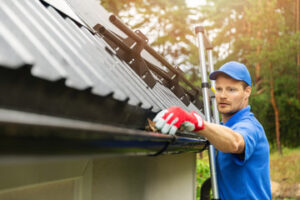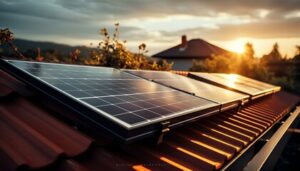Charleston Gutter Cleaning is a task often overlooked by homeowners, but it’s an important aspect of property maintenance. It protects homes from water damage, preserving landscapes, preventing pest infestations and extending the lifespan of gutters.

Before starting, set up a tarp or other debris catcher near the ladder. Put on grippy shoes, safety glasses and rubber gloves. Start from the top and work your way down, dumping gathered materials into a bucket as you go along.
Gutter cleaning is the process of eliminating leaves, twigs and other debris from your home’s gutter system. It is an essential step in ensuring that rainwater channels properly into your downpipe, facilitating wastewater management. It is also a critical step in preventing structural damage to your property, such as soil erosion and foundation cracking. Regular gutter cleaning is recommended for homeowners, as it will help to avoid costly repair and maintenance work.
While it is possible to clean your own gutters, hiring a professional service will ensure that the job is done safely and correctly. This will prevent water damage to your house and its contents, as well as reducing the risk of mold and mildew growth. Professionals have access to the proper equipment for the task, including sturdy ladders and safety harnesses to prevent falls. They will also have the knowledge and experience to tackle difficult jobs like clogged gutters that are located near power lines or poles.
When tackling this task yourself, it is a good idea to have a spotter to keep an eye on you while you are on the ladder. It is also a good idea to use a bucket to collect the debris, which can then be easily lowered down to the person spotting you. A tarp can also be helpful for keeping the clean up process organized and efficient.
In addition to a ladder, you will also need a pair of thick gloves and eye protection. Gloves will protect your hands from dirty, rotting leaf debris that may contain bacteria. They will also protect your fingers from being poked by metal shards. Eye protection is a must because you never know what might fly out of the downspout when you are removing a clog. People have experienced rats, birds, frogs, bees and wasps flying out at high speeds when they were removing a clog!
Once you have removed the debris from the gutters, it is a good idea to rinse them down with a garden hose. This will help to remove any residual dirt and sediment, as well as ensuring that the downspouts are clear of blockages. If a downspout becomes stuck, you can try using a plumber’s snake to dislodge the blockage.
Tools
Gutter cleaning is a necessary part of home maintenance that can protect your house from water damage, foundation issues, and pest infestations. However, it can be a time-consuming and messy job that requires special equipment to be effective. There are many different gutter cleaning tools available, including gutter vacuums, leaf blowers with specialized attachments, and telescoping gutter-cleaning wands. The right tool will depend on the type of debris and the extent of clogging.
When dealing with light debris, such as leaves and pine needles, a leaf blower with a long, angled attachment can quickly remove them from your roof and gutters without the need for a ladder. This technique works best when the debris is dry.
For more substantial clogs, you’ll need a gutter cleaner that can handle high volumes of dirt and grime. There are several options for this, but the most common is a telescoping gutter-cleaning hose with a nozzle that can be attached to a garden hose and extended to reach high areas. This tool uses forced water to dislodge and wash away clogs, and can also be used to clean other parts of the house and yard.
Another option is a gutter brush with an extendable handle that allows you to remain on the ground and sweep away cobwebs, dirt, and gunk from your gutters with minimal effort. This can be a safer option than climbing on a ladder, but it may not be as effective as the telescoping hose or a gutter scoop.
For homes with multiple stories or steep angles, a safety harness can be an important addition to your gutter-cleaning arsenal. It can help prevent falls when working on a ladder, and is particularly useful for those with trouble reaching higher areas of the gutters. Work gloves and goggles should also be worn to prevent cuts or eye injuries from debris, sharp objects, or splashes of power washing water. In addition to these basic cleaning tools, you’ll likely need a ladder, buckets for collecting debris, and a broom or trowel for scooping out stubborn residue.
Equipment
Gutter cleaning is a labor-intensive task that requires climbing ladders, hauling debris to the ground, and disposing of it. To speed up the process, a sturdy ladder with stabilizers is essential, as is a bucket to hold waste and a garden hose for blasting away gunk. A small brush and gloves are also useful for scrubbing away any leftover residue. A tarp can be helpful in keeping mess off the ground, but it should be positioned properly so that it is not blowing in the wind and splattering on your house.
Gutter vacuums and extension wands are other useful tools that can be used to remove waste more quickly. These machines are more expensive, but they can save significant time in the long run as they cut down on climbing ladders and the need to dump debris. Some gutter vacuums even come with camera attachments so that you can see what you are doing while working.
A more hands-off option is a robot gutter cleaner, which you set in your gutter and then control remotely. This device has treads or wheels that allow it to navigate muck and gunk easily, and most of them are powered by rechargeable batteries.
For the most thorough job, it is best to schedule gutter cleaning twice a year—once in the spring and once in the fall. This will prevent the buildup of clogs and other debris, reducing the frequency of future cleanings.
The best way to avoid clogs is to install gutter guards, which keep debris from entering the gutter and can significantly reduce the number of times your gutters will need to be cleaned. However, if you are unable to get rid of the clogs, it is best to clean out your gutters regularly to prevent them from overflowing.
For businesses that offer gutter cleaning services, the right technology can make a big difference in reducing service delivery time and improving efficiency. Route optimization, client communication and scheduling, and job tracking are all easier with the right software solution. Success stories abound of companies that have utilized these technologies and expanded their customer base without sacrificing service quality.
Time
Having clean gutters is crucial to your home’s health. Gutters control rainwater and snow/ice melt by carrying it from the roof to the ground through downspouts that divert water away from your foundation, walls, and landscaping. If they are clogged, water can back up and cause serious damage to the house. Fortunately, it’s an easy problem to prevent by cleaning your gutters regularly.
Gutter cleaning involves eliminating leaves, twigs, debris, and other elements from the gutter system. The process usually takes around two to three hours for a single-story home with average-sized gutters. However, the process can take longer for houses with multiple story, large-sized gutters, or a heavily clogged gutter system.
Getting your gutters cleaned regularly is an inexpensive way to protect your home’s foundation, exterior walls, and landscaping. It also helps prevent expensive repairs and maintenance costs by reducing the risk of damage from water overflowing and pooling in the gutters. It also reduces pest infestations, as standing water creates an ideal habitat for mosquitoes and other harmful insects.
How often you should clean your gutters depends on several factors, including the climate in your area and the number of trees around your home. If you have many trees that shed their leaves throughout the year, you’ll likely need to clean your gutters more frequently. It’s best to schedule gutter cleaning services twice per year, once in the fall and again in the spring.
Gutter cleaning is a difficult job for most homeowners, but with some basic tools and a little help from a friend, it’s not impossible. You’ll need a ladder, safety equipment, and a bucket or scooper to remove the debris from the gutters. It’s also important to plan ahead for the project by gathering your tools, preparing your ladder, and ensuring it’s safe. If you hire a professional service, they’ll provide an estimated timeframe after assessing your property. They are expert at sizing up the situation and can clean most homes in just 1 to 3 hours. If you’re going the DIY route, expect it to take much longer.

